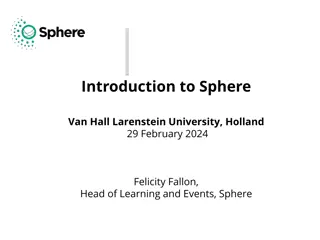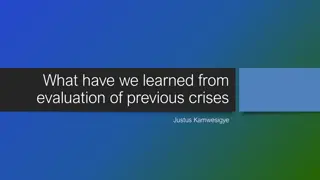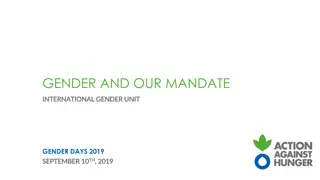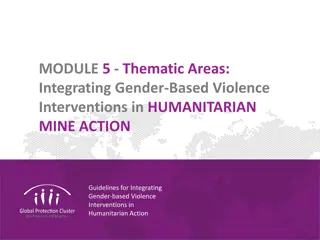Gender Equality Practices in Humanitarian Aid Organizations
Internal organizational practices play a crucial role in ensuring gender equality in organizations delivering humanitarian aid. This includes resource allocation, policies, accountability, and staff training. Oxfam's Minimum Standards outline key practices for promoting gender equality. Accountability and leadership are emphasized for influencing broader inter-agency coordination and mainstreaming gender across humanitarian clusters.
Download Presentation

Please find below an Image/Link to download the presentation.
The content on the website is provided AS IS for your information and personal use only. It may not be sold, licensed, or shared on other websites without obtaining consent from the author.If you encounter any issues during the download, it is possible that the publisher has removed the file from their server.
You are allowed to download the files provided on this website for personal or commercial use, subject to the condition that they are used lawfully. All files are the property of their respective owners.
The content on the website is provided AS IS for your information and personal use only. It may not be sold, licensed, or shared on other websites without obtaining consent from the author.
E N D
Presentation Transcript
Slide 1 Internal organizational practices The internal practices of an organization delivering humanitarian aid need to reflect and support its programme objectives on gender equality. Critical institutional shifts are often needed in: human and financial resources; policies, procedures and standards; staffing and gender-sensitive recruitment practices; accountabilityframework; organizational culture.
Slide 2 Oxfam Minimum Standards for promoting gender equality through internal practice in emergencies Ensure allocation of appropriate financial and human resources for the promotion of gender equality (MS1) Ensure that workplace policies and procedures are in place and communicated to staff and partners to ensure gender equality in the workplace. These should include anti-sexual harassment HR policies (MS2) Ensure accountability of senior management for promoting gender equality (MS3) Develop staff, partner and senior management capacity through inductions, training and reflections(MS4)
Slide 3 What do we need to do to work above the line on gender equality during humanitarian crises? Levels of accountability Take action and learn Findsolutions Accept ownership Make ithappen, renewal This canwork It starts withme Learn and Grow Empowered Acknowledge situation Wait n hope I m a piece ofthe puzzle Somebody should dosomething It s myfault Protect and Defend Blame self Blame others It s their fault Denial Woe isme Wait n hope This has nothing to do withme
Slide 4 Inter-agency coordination on gender in humanitarian action Gender leadership on humanitarian action means influencing not just our own organizations but also the wider humanitarian community. The greatest impact will be leveraged if learning on good practice and how to create change is used to influence practice across the whole inter-agency humanitarian system in country.
Slide 5 The UN cluster system Clusters are the main inter-agency forum at global level for setting standards and policy for specific sectors, and at country level for collaborating and coordinating activities in complex and natural disaster humanitarian emergencies. The protection cluster has a different structure than others and is divided into key areas of protection called areas of responsibility . These include gender- based violence, which is led by UNFPA at the global level, protection, mine action and housing, land and property. Gender, age, HIV/AIDS and environment do not have their own cluster but are cross-cutting. Therefore it is necessary to work across the clusters to mainstream gender into their work
Slide 6 Maya Angelou (author andpoet) I have learned that people will forget what you said, people may forget what you did, but people will never forget how you made them feel.
Slide 7 The feminist leadership diamond Politics andPurpose Power Principles and Practices Values
Slide 8 Action planning for partner organizations Questions to guide planning 1.What has been the most useful learning this week in terms of your organization s capacity needs on gender in humanitarian work? 2.What are the key areas you feel you need to work on as an organization? 3.Within those areas, what are your top priorities for the next 6 months? 4.How do you plan to take those forward in terms of: what support and resources will be needed? Who will be in charge? What timeframe? 5.What do you need to do next as colleagues to consolidate your combined gender leadership and bring others in your organization along with you? Look back to the flip chart created in the last session on the roles and activities of the gender leader.
Slide 9 Action plan for partner organization For example: Conduct training for senior management team Initiative/areas Support/resources needed Staff time, venue fortraining, training materials Humanitarian coordinator and gender advisor Staff-in-charge Timeframe September 2016























